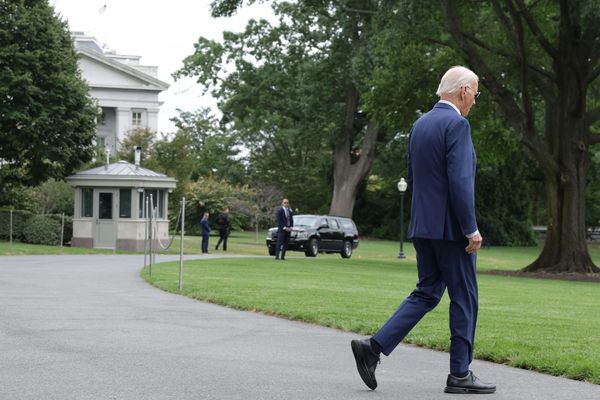
The mid-air engine shutdown that forced a Qantas A330 back to Perth on Monday night after a “loud bang” comes as no surprise to those working on the company’s aircraft, both in the cockpit and on the ground. In fact, sources tell Crikey, it is business as usual with Qantas having engine trouble on a number of fronts.
Coming just days ahead of Easter Thursday, the airline’s busiest day of the year, the loss of (one of) the largest aircraft the airline flies domestically will play havoc with flight schedules.
The 21-year-old A330, the oldest plane in the Qantas fleet, is unlikely to be back in the air for at least a week, engineers told Crikey, and that’s if there is a spare engine in the country.
Pictures of the engine, seen by Crikey, show a broken turbine. The incident is so serious the company has had all the data recorders preserved for investigation by the Australian Transport Safety Bureau (ATSB), insiders said. The incident follows serious problems (previously unreported in the media) with an engine on another A330 where a piece of metal tubing that was part of the turbine case cooling was found poking out of an engine, pilots involved said.
Qantas’ long-haul B787s and A330s, as well as the red tail fleet’s domestic workhorse B737s, are not being given enough downtime for regular checks and tweaks including on their engines, engineers and pilots said.
“If you don’t give a plane enough downtime, it will eventually do it for you,” one engineer explained.
The B787s, the youngest planes in the Qantas fleet, are having trouble with badly overheating engines resulting in a “couple of turnbacks” in South Africa, pilots said. One of those was due to an engine that had overheated by 40 degrees. It was given a temporary certificate for 10 more flights and was then removed from service completely. Qantas had no spare General Electric engines used by the 787s so it was forced to take one from a Jetstar 787.
This week’s engine failure comes 14 months after another major engine failure, on a B737 from Auckland to Sydney, that was investigated by the ATSB and where voice recorders were “inadvertently” written over.
Sources say the engine problems are the direct result of the chronic underinvestment in aircraft — there is no spare capacity at all — and the company’s engineering workforce and spare parts by former CEO Alan Joyce. The penny-pinching maintenance regime he instituted has been underpinned by the airline’s wholesale outsourcing of core capabilities, designed to boost profits and executive bonuses, which has continued under Joyce’s successor Vanessa Hudson.
The company now undertakes all its frontline heavy maintenance for its international planes offshore in a range of places including Los Angeles, Manila, Singapore and Abu Dhabi. In a bid to trim inventory costs, it keeps few, if any, major parts such as engines in Australia. This is at a time when its planes are ageing and being worked harder than ever, meaning chances of major mechanical and electrical issues are rising — and are taking longer to fix.
This causes the serial delays and cancellations that have plagued the airline since the end of pandemic lockdowns. Fresh data last week showed the airline cancelling one in 20 flights. All the management consulting in the world — Hudson has called in McKinsey to help the planes run on time — can’t create a younger fleet, pull new aircraft out of thin air, or birth experienced engineers.
The airline is so short of long-haul aircraft it “wet leased” — using Finnair flight deck and cabin crew — two Finnair A330s now flying Sydney-Singapore/Bangkok routes.
A promised engineers academy will not even begin training people in three year courses until 2025 if it is on time. Qantas is presently plugging the hole in its already ageing engineering workforce by bringing back retirees, many of whom were forced into redundancy by Qantas during the pandemic. These workers are only a short-term solution, engineers said, and reflect a workforce whose average age is about 55.
“We have 15 apprentices. We need double or triple that a year going forward,” an engineer in Sydney said.
Moreover, the company’s dire shortage of long-haul planes just got worse, with regulators demanding fresh checks for wing-crack prone A380s, the world’s largest commercial aircraft. Qantas now has four of these parked in Abu Dhabi (thanks to outsourcing) and the return to service of three will now be delayed.
One is due back next week. One has wing cracks, delaying its return by about six weeks. Another needs a 12-year check and will be parked in Abu Dhabi until late this year. And the last has run out landing gear cycles and needs a new interior. It won’t be back into service until late this year or early next, all of which is very poor planning by Qantas, engineers said.
Qantas did not respond to detailed questions about its aircraft.
The airline has belatedly ordered new B787 and A350 long-range aircraft but the former are not scheduled to arrive until at least late 2026 and the latter until 2032 — timetables that now look doubtful, with manufacturers Boeing and Airbus experiencing heavy demand and warning of delivery delays.
In the meantime the “Flying” Kangaroo will continue to limp along with its ever-ageing fleet and bung engines. The losers, as usual, are the flying public, and Qantas aircraft-related staff.
Do you feel safe flying Qantas? Let us know by writing to letters@crikey.com.au. Please include your full name to be considered for publication. We reserve the right to edit for length and clarity.







